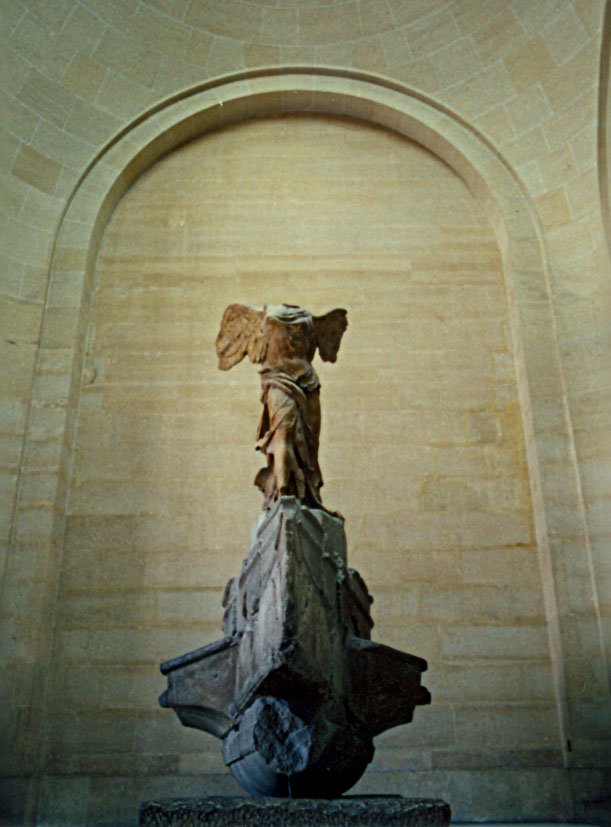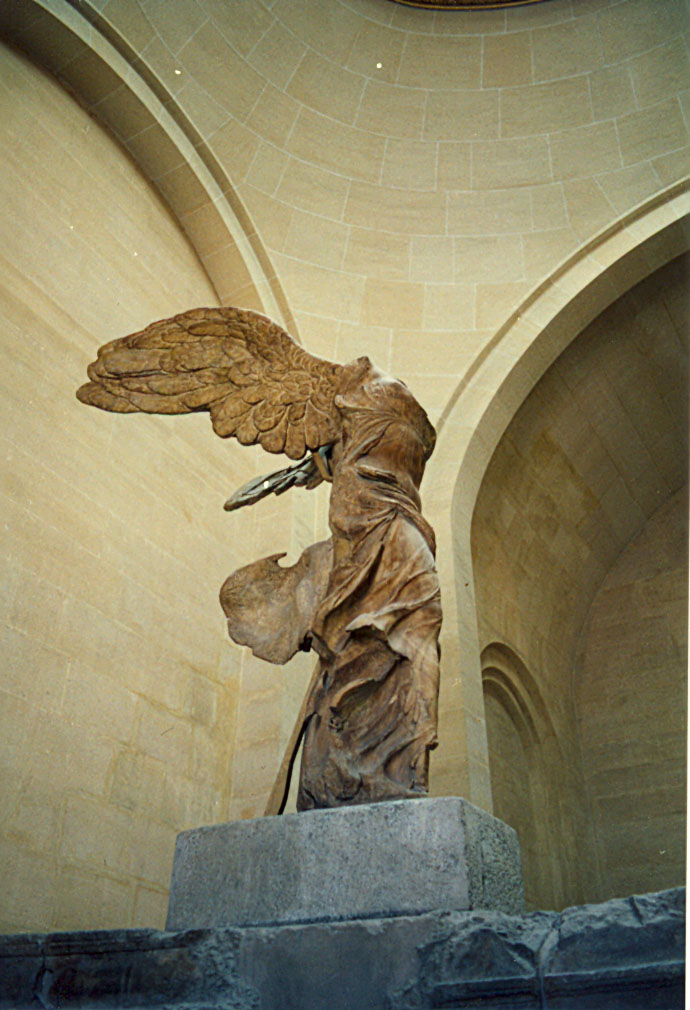This is a collaborative work between two composers, Theo Goldberg who created the images with the aid of Vax and Amiga computers, and Barry Truax who created the music with real-time granular synthesis. The work is in four sections. The visuals are based on a "sampled" visual image of the famous statue, the Winged Victory (or Nike) of Samothrace, and the music is mainly based on two sampled phonemes of vocal sound, one male, the other female. The work is an extension of an earlier collaboration, Divan (1985), which explored sound-image relationships.
The Wings of Nike (three movements) is
available on the Cambridge Street Records CD Pacific Rim (whose cover features one of the graphic images
used in the piece) and the four movement version on the Perspectives of New Music
CD, PNM 28.
A complete documentation analysis of the work
(with visuals) is also available on the WSP Database (contact
Barry at truax@sfu.ca for guest access) and the entire work is
available as a video on DVD which
can also be seen here.

![]() Sound Example available
Sound Example available
** A new Octophonic version is now available (3 movements) **
Despite the brevity of the source material used for Nike (i.e. two phonemes), very rich textures and complex rhythmic patterns were obtained from it through the technique of granulation. The pitch and timbre of the resulting sound are determined by the source material unless the grain duration is too short and a broad-band spectrum results. However, the overlay of up to 20 simultaneous versions of such sound, each with its own variations, produces a "magnification" of the original sound, as well as the possibility of gradual or rapid movement through its micro-level characteristics.
The degree of magnification involved can be appreciated when it is realized that three of the movements of The Wings of Nike, lasting approximately 12 minutes, were derived from only the two phonemes, each about 170 ms long! The stereo tape is a mixdown from an eight-track original which includes four stereo pairs of the granular material, and therefore the vertical densities of sound are around 80 at any one moment, and the horizontal densities range from quite sparse through to 8,000 events per second at the very end. The sounds are heard at approximately their original pitch combined with versions an octave up or down, except towards the end of the first movement (Album) where a slow downward glissando is heard.
In the case of the male phoneme sequence ("tuh"), derived from Norbert Ruebsaat's speaking the word "touch", timbral changes are possible as the grains move (with changing offset) from the aspiration at the beginning of the sample, through the consonant to the pitch of the voiced vowel and finally past it. Microscopic timbral changes that normally go unnoticed become evident with the repetition of the overlapping grains. Formant regions become especially pronounced. The analogy in the work is between the sampled visual image of the statue and the sampled vocal sound as the source of the synthesized music. Each is based within the human dimension but the transformation techniques extend them towards the epic and the supra-human, as at the end of the first movement.
In the second
movement, the Scherzo, the statue is given a head,
though rather androgynously, and the phonemes in the tape part
are detached and realistic. However, each image accumulates
again into more elaborate patterns that mask the source. In
the last movement, the Coda, both the visual and aural
elements are progressively multiplied (the wing feathers and
drapery in the visual case, and the syncopated phonemes in the
musical accompaniment) until fusion results. A new kind of
machine emerges that releases the earth-bound images into
upward flight, a metaphor perhaps for the technique of granular synthesis that seems to break into a new sonic domain.
The third movement, The Illuminated Nike,
which is sometimes omitted in performance or recordings, was
realized with FM grains and slow ramps and cross-fades. The
differing spectral colours produced by various c:m ratios in FM is intended to be analogous to the
various types of illumination of the statue as seen in the
visuals.
Reference: B. Truax, "Composing with Real-Time Granular Sound," Perspectives of New Music, 28(2), 1990.
 |
 |
The Winged Victory, or Nike of Samothrace, in the Louvre Museum, Paris.
Technical note
The computer images realized with a Vax at the University of British Columbia in Vancouver were produced by a Ramtek frame buffer and Metheus monitor display, controlled by customized software by Robert Ross based on the LIG language. The music was synthesized by the DMX-1000 Digital Signal Processor controlled by a PDP Micro-11 computer with software for real-time granular synthesis developed by Barry Truax in the Centre for the Arts at Simon Fraser University. Sound densities ranging up to 2500 events/second were recorded on 8-track tape and mixed down in the Sonic Research Studio at SFU.